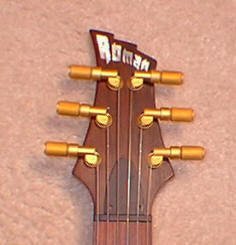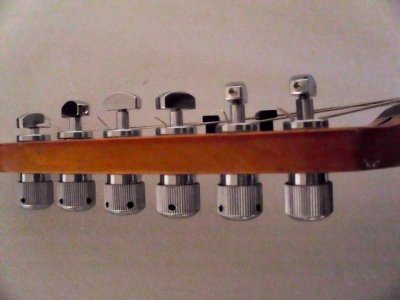According to? By that logic, are you saying that the uinque gear ratio for each string on the new Graphtech Ratio tuners is just a marketing gimmick?
Because, let's compare apples to apples. I have had Grover-made Kluson style tuners and standard kidney Grover in the same guitar. Both bought recently, so they're not from different eras or anything. Not from a different manufacturer either, and likely not from a different factory or manufacturing process even. The Grover Kluson types were 14:1. The normal Grovers were 18:1. I could definitely feel a difference. Now, the Kluson-type Grovers weren't bad, and they weren't overly unstable either, but the 18:1 felt smoother and tuned more accurately. Subtle, perhaps, but noticeable. And given the option, why choose the worse of the two?
I've also had Gotoh 510's in the past with the 21:1 gear ratio, and those were insanely smooth. But that's a whole other manufacturer, and build quality tolerances.
Now, there were some benefits to the Kluson-style Grovers that I myself did not value enough to keep them. But they were indeed lighter, and they had the vintage look. Sperzels have neither of those admittedly subjective benefits.
Like I said, I'm not denying the quality of Sperzels. I am not even saying they are bad tuners. But they are not the only well-made tuners being offered nowadays. And I find there are better options as other manufacturers have caught up on the whole locking tuner phenomena. I personally don't agree with peoplle who defend them on the basis on how well they are made, but I accept that's just an opinion. Hell, I even understand why some people would like to go with Sperzels because they are a well-established brand with a trust-worthy design. But I do think looking a bit beyond them into what else is being offered nowadays can go a long way. I've been obsessing with tuners ever since I got frustrated with my first few cheapy guitars with attrocious tuning stability, so I've gotten my hands on as many as I could, Sperzels included.
Summing up, my joke's only implication is that I would never change Gotohs for Sperzels for the reasons I explained.
Ill explain it like this.... the best human ear can discern a pitch variation know as "JND". of about 5 cents, a trained musician of average hearing is something of 5-10 cents, and the average ear on the street more then 20 cents, -so lets call that the "resolution" of a gearing system in that how fine the incremental resolution defines how accurately you can place a tuning.of a guitar -but if you consider a gearing ratio of 12:1 can place a string within about 2 cents a resolution -which is more accurate than most guitarist electronic tuners had resolution of until the last 2 decades and way more accurate than a human can hear. a machine head of regular modern gear ratio -like 12:1 or 14:1 has plenty of resolution to serve a guitar players purpose -and by a large margin for human hearing
Second your guitar with equal temperament was wildly more variable in pitch regardless of how accurate your machine heads are. Equal temperament basically says your guitar is going to be out of tune as much as 14 cents in places around the fretboard, and maybe more based on the actual guitar -likely 20 cents. =so what has the extra resolution on a tuner gained you if you guitar fundamentally is not set up accurately enough to control that resolution, nor has your ear the ability to discern the advantage if you had more ratio. fundamentally the design of guitar is flawed well beyond what the lesser resolution of a machine head is.
Next the guitar itself is going to vary 1-10 cents when it vibrates because of the the bridge play, vibration of the entire body, stiffness of the neck, binding and slippage of the nut, variation of crown on the fret wear, and especially the fact that plucking a string by nature will make it sharper by multiple cents in the attack and flatten as it's orbit resolves to a static state -Fundamentally playing a guitar is way more out of tune than the resolution achieved from a high ratio tuner.
Next, what is of most concern is machine quality in a tuner -the fitment of the gearing dictates how accurate the ratio is -a 12:1 machine head which is machine to a certain accuracy can actually bring a pitch to it's finest accuracy and hold it in place versus a cheaper higher ratio machine with slack in their machining process. This is why Sperzel has never changed their ratio -because their machining is so accurate that it achieves the control and hold suitable for guitar players. Next, the slack or play in any gear system creates the phenomena of slippage -it's all about machine quality to prevent this -so choosing a machine on quality or a technology that mitigates this like avoiding the traditional offset gearing in the first place.
Next, actual gear ratio is just the ratio of how many turns the the button head must make for 1 turn of the post -but this isn't an apples to apples comparison between machine heads manufacturers "resolution" unless the post size is standard and the string size is the same -which many modern systems have different post sizes -so a 14:1 on system could achieve the same resolution of a 16:1 of another -and it gets even more confusing to compare tuners when you compare to some of the new systems which don't use a traditional post winding system and post super high ratio. So just quoting ratio between mfgs may be misleaded
So there's nothing wrong with wanting more resolution on your tuner -especially with tuners now that can do <1 cent resolutions -especially if you are using true temperament guitars -if fact thats the place where higher ratios may make more sense. and there's nothing wrong with wanted a smoother feel on your tuner because you are ok with tuner your tuners way more -but anyone whos used a Grover Rotomatic 18:1 knows its hard to find any tuner that feels better than that. So in summary, high ratio tuners were marketed like an arms race in the early 2000s and it got pretty silly, as the higher ratio doesnt really provide a tuning accuracy advantage for a human ear and terribly flawed equal temperament guitar.... where they are cool is if they feel good to you and you are ok with more turns and possibly chasing a pitch on a tuner swinging back an forth a cents as the string resolves. But for a feeling argument, I'd argue that especially Grover, but also Schaller have incredible feeling tuners in lower ratios than the high ratios offerings -so it's not a compelling reason for most people.
So your own ear, your playing, you guitar's western equal temperament setup (presumed maybe you do true temperament), and you audience cannot benefit from the higher resolution of a high ratio but it can totally benefit from high machine quality to hold the pitch from slippage -so it's really a matter of how the tuner feels to you, does it give you confidence, does it feel smooth -which is a personal choice but dont worry about gear ratio on it's own as factor for tuning quality.


